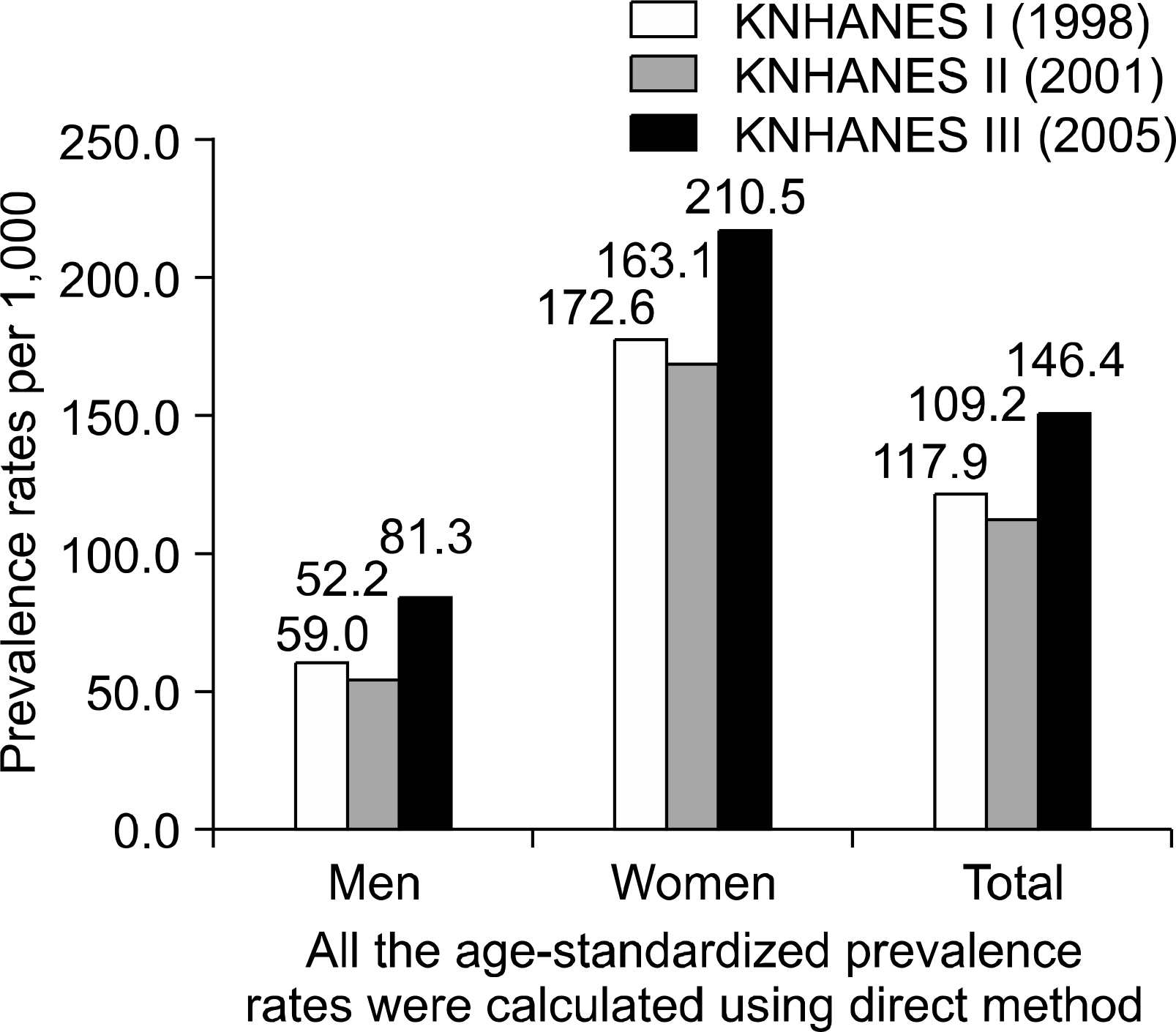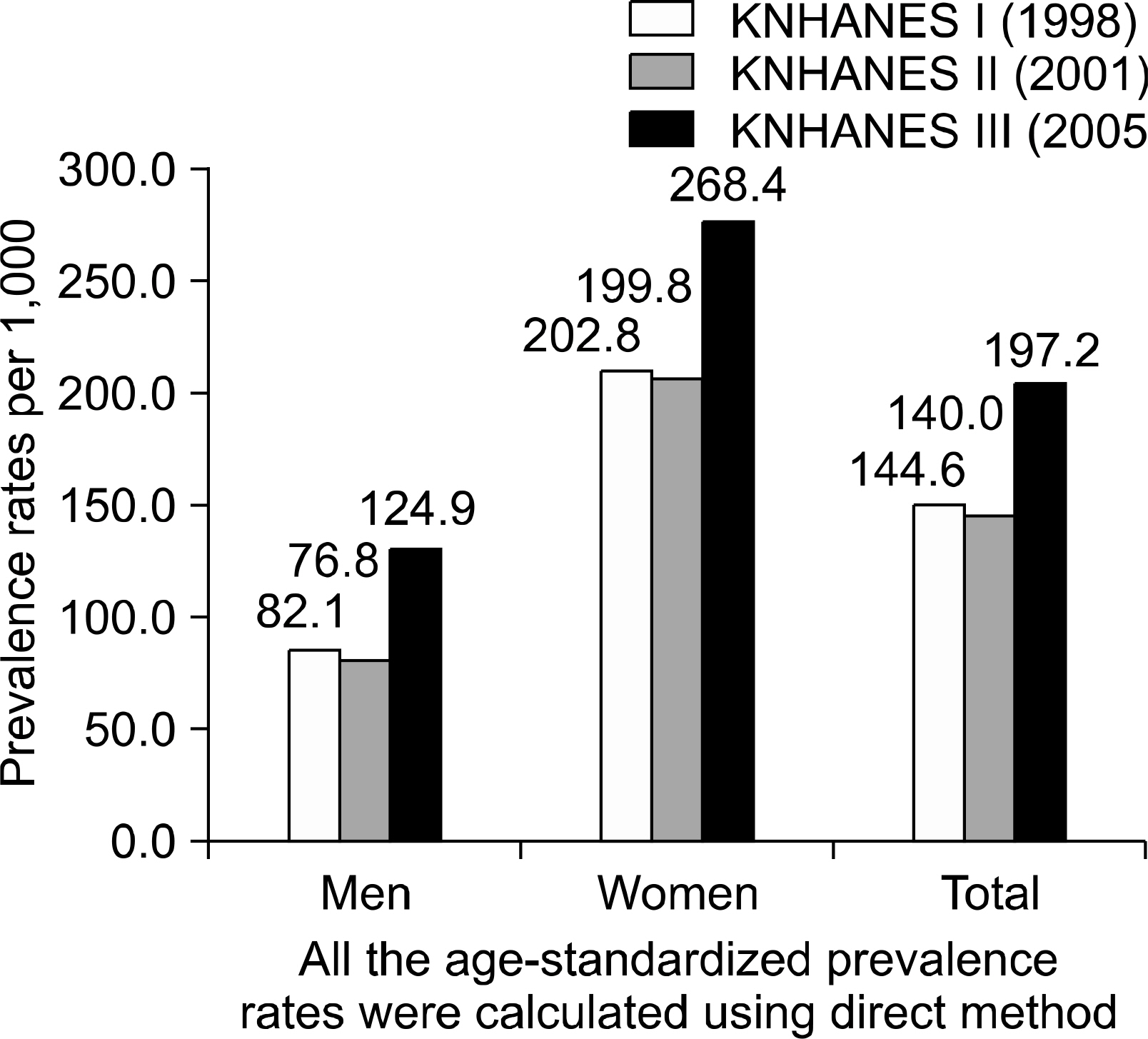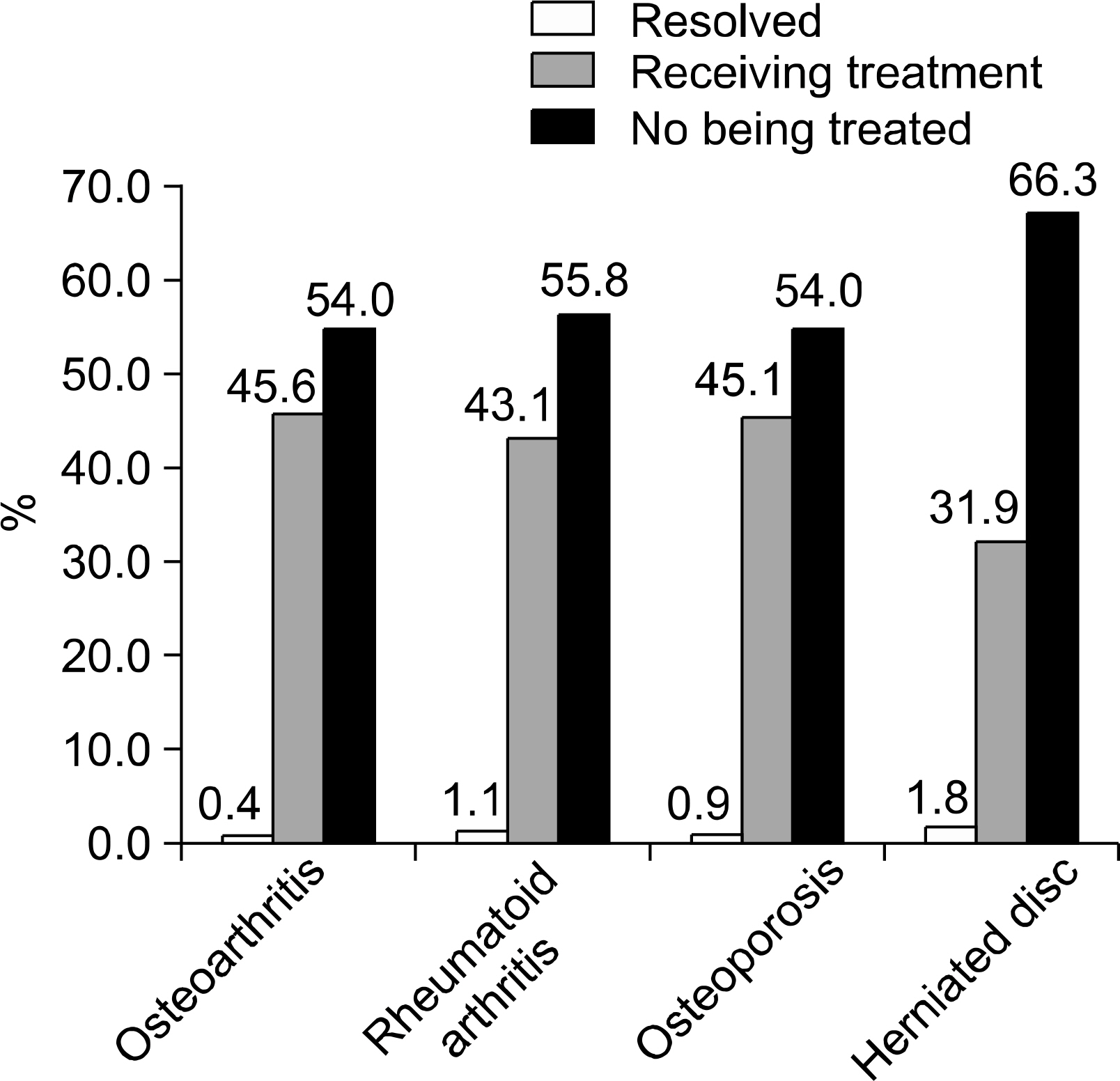The Prevalence and Trend of Arthritis in Korea: Results from Korea National Health and Nutrition Examination Surveys
- Affiliations
-
- 1Division of Rheumatology, Department of Internal Medicine, The Hospital for Rheumatic Diseases, Hanyang University College of Medicine, Hanyang University, Seoul, Korea. scbae@hanyang.ac.kr
- 2BK21 Project for Medical Science, Hanyang University, Seoul, Korea.
- 3Department of Internal Medicine, Dankook University College of Medicine, Cheonan, Korea.
- KMID: 1324505
- DOI: http://doi.org/10.4078/jkra.2008.15.1.11
Abstract
- OBJECTIVE: To estimate the prevalence of musculoskeletal diseases, especially osteoarthritis, rheumatoid arthritis, osteoporosis and lumbar disc herniation, in Korean adults. For arthritis and total musculoskeletal diseases, trend of the age-standardized prevalence rates were evaluated. METHODS: This study was based on the data obtained from the Korea National Health and Nutrition Examination Surveys (KNHANES) I, II and III, conducted in 1998, 2001 and 2005, respectively. KNHANES is a nationwide cross-sectional study using a stratified, multistage probability sampling design for the selection of household units. Annual self-reported prevalence and its confidence interval were estimated in adults aged over 19, using Health Interview Survey in KNHANES. All analyses were done using SAS 9.1 with "survey procedure" except for age-standardized prevalence rates for comparison prevalence rates of each survey. Age-standardized prevalence rates were calculated using a direct-method. RESULTS: The prevalence of musculoskeletal diseases was 144.6, 140.0 and 197.2 and the annual self-reported prevalence of arthritis was 117.9, 109.2 and 146.4 per 1,000 population in 1998, 2001 and 2005, respectively. In KNHANES III, osteoarthritis was the most prevalent disease of the musculoskeletal diseases for both sex. Fifty-eight percent of the over 65 year-old population had at least one musculoskeletal disease and it was higher in women with 73%. CONCLUSION: The prevalence of musculoskeletal diseases was high in Koreans with arthritis being the most prevalent. The prevalence of musculoskeletal disease correlated with low sociodemographic status.
Figure
Cited by 11 articles
-
The Prevalence of Knee Osteoarthritis in Elderly Community Residents in Korea
Inje Kim, Hyun Ah Kim, Young-Il Seo, Yeong Wook Song, Jin-Young Jeong, Dong Hyun Kim
J Korean Med Sci. 2010;25(2):293-298. doi: 10.3346/jkms.2010.25.2.293.Impact of Osteoarthritis on Household Catastrophic Health Expenditures in Korea
Hyoungyoung Kim, Soo-Kyung Cho, Daehyun Kim, Dalho Kim, Sun-Young Jung, Eun Jin Jang, Yoon-Kyoung Sung
J Korean Med Sci. 2018;33(21):. doi: 10.3346/jkms.2018.33.e161.Epidemiology and etiology of rheumatoid arthritis
Sang-Cheol Bae
J Korean Med Assoc. 2010;53(10):843-852. doi: 10.5124/jkma.2010.53.10.843.Evaluation of Automated Assays for Measuring Serum Hyaluronic Acid: For the Diagnosis of Rheumatoid Arthritis
Mi-Soon Han, Yongjung Park, Hyon-Suk Kim
Lab Med Online. 2014;4(2):98-104. doi: 10.3343/lmo.2014.4.2.98.Epidemiology of Rheumatoid Arthritis in Korea
Hyoungyoung Kim, Yoon-Kyoung Sung
J Rheum Dis. 2021;28(2):60-67. doi: 10.4078/jrd.2021.28.2.60.Treatment of Rheumatoid Arthritis Patients with Chronic Hepatitis B: Analysis of Korean National Health Insurance Claims Data
Kichul Shin, Hyeongap Jang, Won Mo Jang, Jin-Seok Lee, Yeong-Wook Song
J Rheum Dis. 2013;20(1):24-29. doi: 10.4078/jrd.2013.20.1.24.Nutrient Intake in Postmenopausal Rheumatoid Arthritis Women with Osteoporosis: Results from the Korean National Health and Nutrition Examination Survey
Yeon Soo Baik, Jee Won Park, Jihye Kim, Won Gyoung Kim, Sohee Oh, Sung-il Cho, Yeong Wook Song, Kichul Shin
J Rheum Dis. 2017;24(1):35-42. doi: 10.4078/jrd.2017.24.1.35.Characteristics of Korean Patients with RA: A Single Center Cohort Study
Yun Jung Kim, Chan-Bum Choi, Yoon-Kyoung Sung, Hyeseon Lee, Sang-Cheol Bae
J Korean Rheum Assoc. 2009;16(3):204-212. doi: 10.4078/jkra.2009.16.3.204.The Prevalence and Clinical Features of Musculoskeletal Diseases in Incheon: Results from Chronic Disease Management Surveys
Hyo-Jin Choi, Woo-Jin Han, Jeong-Soo Im, Han-Joo Baek
J Korean Rheum Assoc. 2009;16(4):281-289. doi: 10.4078/jkra.2009.16.4.281.The Current Status of Surveys on Prevalence of Rheumatic Diseases in Korea
Sang-Cheol Bae
J Korean Rheum Assoc. 2010;17(1):1-3. doi: 10.4078/jkra.2010.17.1.1.Regenerative Medicine in the Treatment of Sports Injuries: Prolotherapy and Extracorporeal Shock Wave Therapy
Dong Rak Kwon
Korean J Sports Med. 2016;34(1):1-9. doi: 10.5763/kjsm.2016.34.1.1.
Reference
-
References
1. Brooks PM. The burden of musculoskeletal disease-a global perspective. Clin Rheumatol. 2006; 25:778–81.
Article2. Mili F, Helmick CG, Zack MM. Prevalence of arthritis: analysis of data from the US behavioral risk factor surveillance system, 1996–99. J Rheumatol. 2002; 29:1981–8.3. 엄완식, 윤정이, 박용욱, 김혜련, 남정자, 이혜순 등. 한국인 관절염의 본인인지 유병률과 역학적 특성: 1998 국민건강ㆍ영양조사. 대한류마티스학회지. 2004; 11:116–26.4. 보건복지부ㆍ질병관리본부. 국민건강영양조사 제3기 (2005) 총괄보고서. 2006.5. 보건복지부ㆍ질병관리본부. 2005 국민건강영양조사 진행보고서 – 건강면접 및 보건의식행태조사. 2005.6. 남정자, 김혜련. 1998년도 국민건강ㆍ영양조사 진행 보고서. 보건복지부. 1999.7. 남정자. 2001년도 국민건강ㆍ영양조사 진행보고서. 보건복지부. 2002.8. 보건복지부ㆍ한국보건사회연구원. 한국인의 주요 상 병 및 건강행태 분석 – 2001년 국민건강ㆍ영양조사 건강부문 심층분석 결과. 2003.9. Kopec A, Rahman M, Berthelot JM, Petit C, Agha-jania J, Sayre EC, et al. Descriptive epidemiology of osteroarthritis in British Columbia, Canada. J Rheumatol. 2007; 34:1–8.10. Centers for Disease Control and Prevaention (CDC). Prevalence of self-reported arthritis or chronic joint symptioms among adults – United States, 2001. MMWR Morb Mortal Wkly Rep. 2002; 51:948–50.11. Wilkins K. Incident arthritis in relation to excess weight. Health Rep. 2004; 15:39–49.12. 박남규, 김우규, 신동혁, 최영미, 이윤종, 이은봉 등. 두 지역사회에서 골관절염 및 류마티스 관절염의 유 병률. 대한류마티스학회지. 2003; 10:147–51.13. Anderson JJ, Felson DT. Factors associated with osteoarthritis of the knee in the first National Health and Nutrition Examination Survey (NHANES I). Evidence for an association with overweight, race, and physical demands of work. Am J Epidemiol. 1988; 128:179–89.14. Dillon CF, Rasch EK, Gu Q, Hirsch R. Prevalence of knee oesteoarthritis in the United States: arthritis data from the Third National Health and Nutrition Exami-natin Survey 1991–94. J Rheumatol. 2006; 33:2271–9.15. Pedersen MS, Jacobsen E, Klarlund M, Frisch M. Sociosconomic status and risk of rheumatoid arthritis: a Danish case-control study. J Rheumatol. 2006; 33:1069–74.16. 보건복지부ㆍ한국보건사회연구원. 1998 국민건강ㆍ 영양조사 총괄보고서. 1999.17. 보건복지부ㆍ한국보건사회연구원. 1998 국민건강ㆍ 영양조사 건강부문 심층․연계 분석. 2000.18. Symmons D, Turner G, Webb R, Asten P, Barrett E, Lunt M, et al. The prevalence of rheumatoid arthritis in the United Kingdom: new estimates for a new century. Rheumatology. 2002; 41:793–800.
Article19. Rousculp MD, Long SR, Wang S, Scheonfeld MJ, Meadows ES. Economic burden of osteoporosis-related fractures in medicaid. Value Health. 2007; 10:144–52.
Article20. Ray NF, Chan JK, Thamer M, Melton LJ III. Medical expenditures for the treatment of osteoporotic fractures in the United States in 1995: report from the National Osteoporosis Foundation. J Bone Miner Res. 1997; 12:24–35.
Article21. Vanness DJ, Tosteson AN. Estimating the opportunity costs of osteoporosis in the United States. Top Geriatr Rehabil. 2005; 21:4–16.
Article22. Rubin DI. Epidemiology and risk factors for spine pain. Neurol Clin. 2007; 25:353–71.
Article23. Manek NJ, MacGregor AJ. Epidemiology of back disorders: prevalence, risk factors, and prognosis. Curr Opin Rheumatol. 2005; 17:134–40.
Article
- Full Text Links
- Actions
-
Cited
- CITED
-
- Close
- Share
- Similar articles
-
- Socioeconomic and Employment Status of Patients with Rheumatoid Arthritis in Korea
- Trends in Inequality in Cigarette Smoking Prevalence by Income According to Recent Anti-smoking Policies in Korea: Use of Three National Surveys
- Top 10 Dietary Supplements of Korean Adults from the 4th Korea National Health and Nutrition Examination Survey
- Comparison of estimates and time series stability of Korea Community Health Survey and Korea National Health and Nutrition Examination Survey
- Trends in the Prevalence of Obesity and Its Phenotypes Based on the Korea National Health and Nutrition Examination Survey from 2007 to 2017 in Korea




